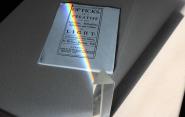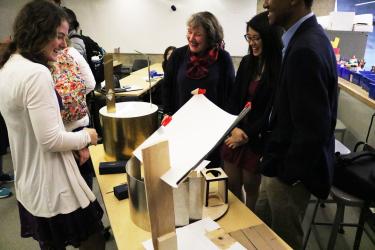Engineering Students Enlightening Museum Goers On Newton

The story of three 18th-century German princesses and their global influence on science and the arts will be told early next year with some help from the students in Engineering Innovation & Design (ENAS 118).
 In February, the Yale Center for British Art (YCBA) will open its exhibit, “Enlightened Princesses,” featuring the German princesses Caroline of Ansbach, Augusta of Saxe-Gotha, and Charlotte of Mecklenberg-Strelitz, all of whom married into the British royal family. They valued science, art, philosophy, and architecture and spent much of their time and resources promoting those pursuits. The exhibit will feature the works of many of the greatest minds of the princesses’ day, including Isaac Newton’s Opticks: or a Treatise of the Reflections, Refractions, Inflections, and Colours of Light.
In February, the Yale Center for British Art (YCBA) will open its exhibit, “Enlightened Princesses,” featuring the German princesses Caroline of Ansbach, Augusta of Saxe-Gotha, and Charlotte of Mecklenberg-Strelitz, all of whom married into the British royal family. They valued science, art, philosophy, and architecture and spent much of their time and resources promoting those pursuits. The exhibit will feature the works of many of the greatest minds of the princesses’ day, including Isaac Newton’s Opticks: or a Treatise of the Reflections, Refractions, Inflections, and Colours of Light.
“It’s a very dense and sophisticated book and the science is difficult,” said Tyler Griffith, a postdoctoral research associate at the YCBA. He said the museum staff did what they could with labels and text, but it was clear that something else would be needed to fully realize the potential of the material.
They spoke with ENAS 118 Instructors Larry Wilen, Center for Engineering Innovation & Design mentor and senior research scientist, and Vince Wilczynski, deputy dean of the School of Engineering and Applied Science. The project soon became a focus of the course.
 The challenge of the project isn’t just a matter of conveying the information accurately, Griffith said. They also want to capture the spirit of Newton’s love of science and sharing his ideas.
The challenge of the project isn’t just a matter of conveying the information accurately, Griffith said. They also want to capture the spirit of Newton’s love of science and sharing his ideas.
“Newton was very much a showman,” he said. “He would travel around the country and do these kinds of parlor shows to demonstrate the laws that he describes in his text. We wanted to capture some of that spectacle and showmanship.”
One student team, comprising Joyce Duan, Lauren Chapey, Stephen Early and Ethan O’Reilly, developed a sculpture-like project that illustrated in three dimensions Newton’s laws of light. The other team of Gemma Hyeon, Duncan Lee, Jessica Greenberg and Jay Son took an interactive approach, with a device that allows patrons to manipulate the prisms. Both teams were advised by grad student Anirudh Narla.
“We lucked out because we got two groups that gave us the opportunity to meet our goals,” Griffith said. The sculptural piece, he said, made Newton’s principles accessible to an audience that “ranges from 6 years old to 96 years old” and the interactive piece captures Newton’s sense of showmanship. “And each one met their goal perfectly.”
The exhibit is a collaboration between YCBA and Historic Royal Palaces, an organization that manages some of the United Kingdom's unoccupied royal palaces. The exhibit will be open at the YCBA from early February through April and at Kensington Palace starting in June.
Among the guests at the final presentations for ENAS 118 was Dr. Joanna Marschner, senior curator for Kensington Palace. She agreed that the two projects are an effective way to bring to life a rather abstract concept.
“I think both of them are absolutely beautiful,” she said.

